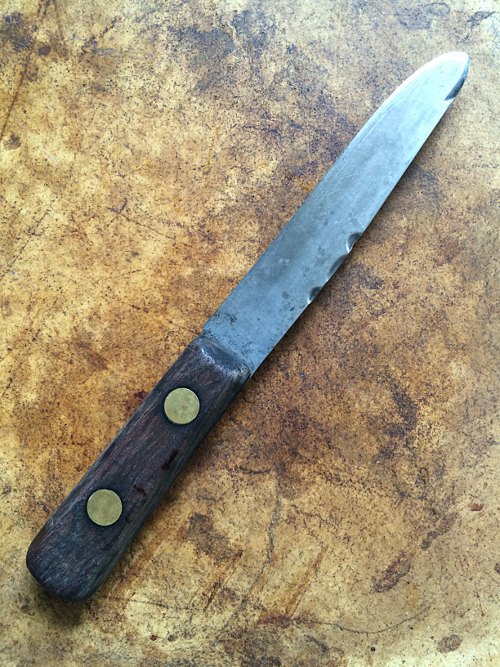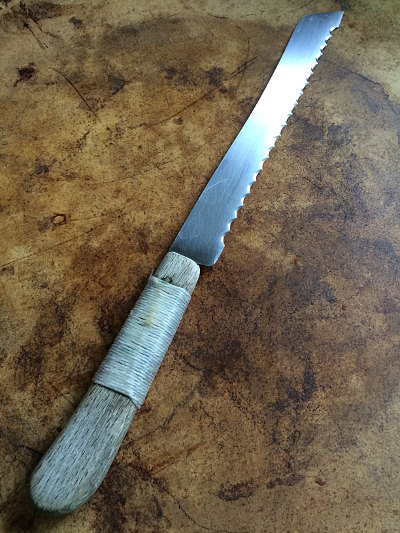
Old Steel Knives and One Cheap One
These essays are now also available in book form, printed on real paper

I’m glad that the blades on my pocket knives (I’ve carried knives made by Leatherman and Swiss Army) are stainless steel, because they have to survive in the wet, in bags I carry while commuting, sometimes in the rain, or while otherwise roughing it. But in my home, I much prefer the non-stainless variety: some are folders (Opinels from France), some straight bladed (flea-market beauties, as above). These blades are sharper, more flexible, and have considerably more character than any stainless blade.
Stainless steel knives are … stainless, and so keep their shiny look. Big deal. Stainless steel is either inexpensive and horrible (inflexible, nearly impossible to sharpen, and brittle), or stupid expensive. When kitchen geeks test knives and make recommendation purely on quality, it could cost you well over $150 (sometimes closer to 800) per knife to follow their advice. When they make recommendations for those on a budget, you can still expect to spend more than $50 on a decent knife (with a plastic handle).
But you can also find an old steel knife at a garage sale, estate sale, or flea market and spend well under $20, then spend a little time with some steel wool, and uncover a beautiful old tool. The handle will be beautiful wood, and maybe you’ll even find one with shiny brass rivets like mine. The old wood handle adds fathoms of character, feels warmer and just nicer in your hand, and is in fact more resistant to bacteria growth than synthetic. That may seem counter-intuitive until you realize that air drying kills bacteria and wood promotes this. a crack or seam between plastic and metal does a great job of creating the kind of environment where stuff can grow.
My steel knives may need to be sharpened more often than an expensive stainless steel knife, but they sharpen like razors. They may need to be protected a bit more from water, but I personally like the patina that metal takes on with age. Age = patina = character = signs of life. Old steel looks, and feels, more natural. That is to say that aging and showing signs of wear is natural, and, in my humble opinion, beautiful.
Allow me to cut to the chase: our culture is obsessed with youth and health: we hate it when anything shows signs of age or wear (before you suggest jeans with holes in them, please note: those holes are probably not signs of age. They are signs of something else, less impressive). Our fear of age and the signs of age applies to utensils as much as it applies to our faces and bodies. And our attempts to counter the effects of age, whether in our own flesh, or in our tools, introduces layers of complexity and expense, and is successful very little of the time.
(Low) tech writer principle #2: When a technological solution is devised to counter the effects of nature, it generally results in a thing being more complex, less flexible, less functional, and/or more expensive.
There are some simple carbon steel blades being made these days that have the qualities I’m talking about: sharp, flexible, not stainless. The problem is that the cheap ones cost close to a hundred bucks and have plastic handles. If you want such blades for cheap, you’ve got to go searching for the cast-offs, and it may take some care to restore them and their handles. But, for me, the satisfaction of polishing an old steel blade and cleaning and oiling an old piece of wood matches the pleasure of using the old tool.
For all the benefits of stainless steel (you won’t catch me arguing that spoons shouldn’t be stainless), I don’t trust it. I wonder if it doesn’t all come down to our distaste for stains … stains that remind us that nature wears things down, marks things with the passage of time. Oh, alright, it’s nice not to have to worry too much about rust, and stainless steel blades will not be ruined by an absent minded cook who doesn’t dry their blades and can’t be bothered to oil them. But then, should we let people who are so absent minded and lacking in respect for tools use sharp utensils anyways? I love old knives partly because you have to take care of them. There, I said it.
Don’t even get me started on those late-night infomercial stars that can cut through an aluminum can. The only reason why these un-sharpenable serrated knives sell so well is that a salesperson comes into your home and tells you what you already know: your knives are dull. Instead of solving this problem (by selling you a good, easy-to-use sharpener so you don’t have to throw away your knives), they sell you another one: a knife that won’t dull so quickly, but that can’t be sharpened by you when it does. This is not to mention the fact that serrated knives have to saw through food, which in some cases just feels wrong. Now, a sharp straight-steel blade cutting through a nice steak? That feels right.
There is one exception to my dislike for serrated blades. There is no other blade for cutting fresh bread. It has to be serrated for something so soft. Thankfully, you don’t have to spend more than 20 dollars to have lots of good choices for a bread knife (but, of course, if you want to spend more than $150 you won’t have to look far, and the choices are few and far between if you want to have a nice wooden handle). The knife below was $6 new, at a fancy kitchen shop no less. The serrations are not some unnecessarily fancy design, but simple scallops that can be sharpened at home with a needle file, or a rotary grinder, which is how I did mine when it was 5 years old and needed a little refresher.

When the handle began to loosen a bit from repeated washings, I just wrapped it tightly with a common whipping, a beautiful and simple binding knot that I use often to repair tools, or finish some other kind of craftwork. (Knots is a subject to which I will have to return.)
